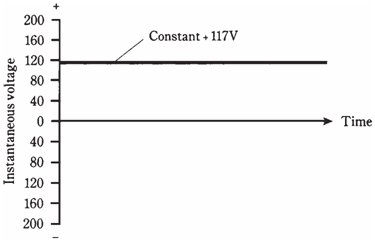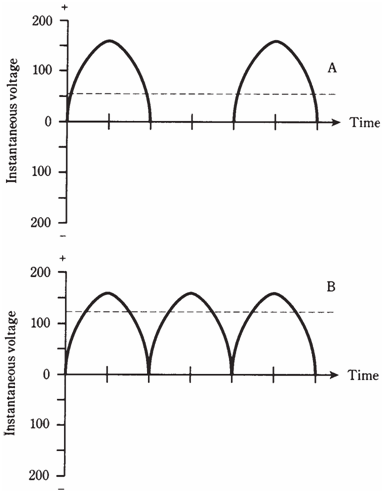Rectification and fluctuating direct current
Batteries and other sources of direct current produce the constant voltage. This can be represented by a straight or horizontal line on a graph of voltage versus time. The peak and effective values are same for the pure dc. But at times the value of dc voltage fluctuates with time, in a manner similar to the changes in an alternating current wave. This might happen if the waveform in given Figure is rectified.

Figure-- A representation of pure dc.
Rectification is a process in which alternating current is changed to direct current. The most common method of doing this uses a device called as diode. Right now, you are not required be concerned with how the rectifier circuit is put together. The point is that part of the alternating current wave is either cut off, or turned around upside-down, so that polarity is same always, either positive or negative.
Figure shows two different waveforms of fluctuating/pulsating, dc. In the waveform at A, the negative part has simply been chopped off. At B, negative portion of wave is turned around and made positive, a mirror image of its former self. The situation at A is called as half-wave rectification, as it makes use of half the wave. At B, the wave has been subjected to the full wave rectification, as all of the original current still flows, even though alternating nature has been changed so that the current never reverses itself.
The effective value, when compared with the peak value, for pulsating direct current depends on whether half-wave or full-wave rectification has been used. In figure, effective voltage is given as a dotted line, and the instantaneous voltage is given as a solid line. The instantaneous voltage changes all the time, from every instant. The peak voltage is maximum instantaneous voltage. Instantaneous voltage is never greater than the peak.
In Fig drawn below the effective value is 0.707 times the peak value, as is the case with ordinary ac. The direction of current flow, for many kinds of devices, does not make any difference. But in Figure half of the wave has been lost. This cuts effective value in half, so that it is just 0.354 times the peak value.

Figure--At A, half-wave rectification of ac. At B, full-wave rectification. Effective values are shown by the dotted lines.
Using the household ac as an example, the peak value is about 165 V; the effective value is 117 V. If full-wave rectification is used, the effective value is still 117 V. If half-wave rectification is used, as in the given figure, the effective value is about 58.5 V.